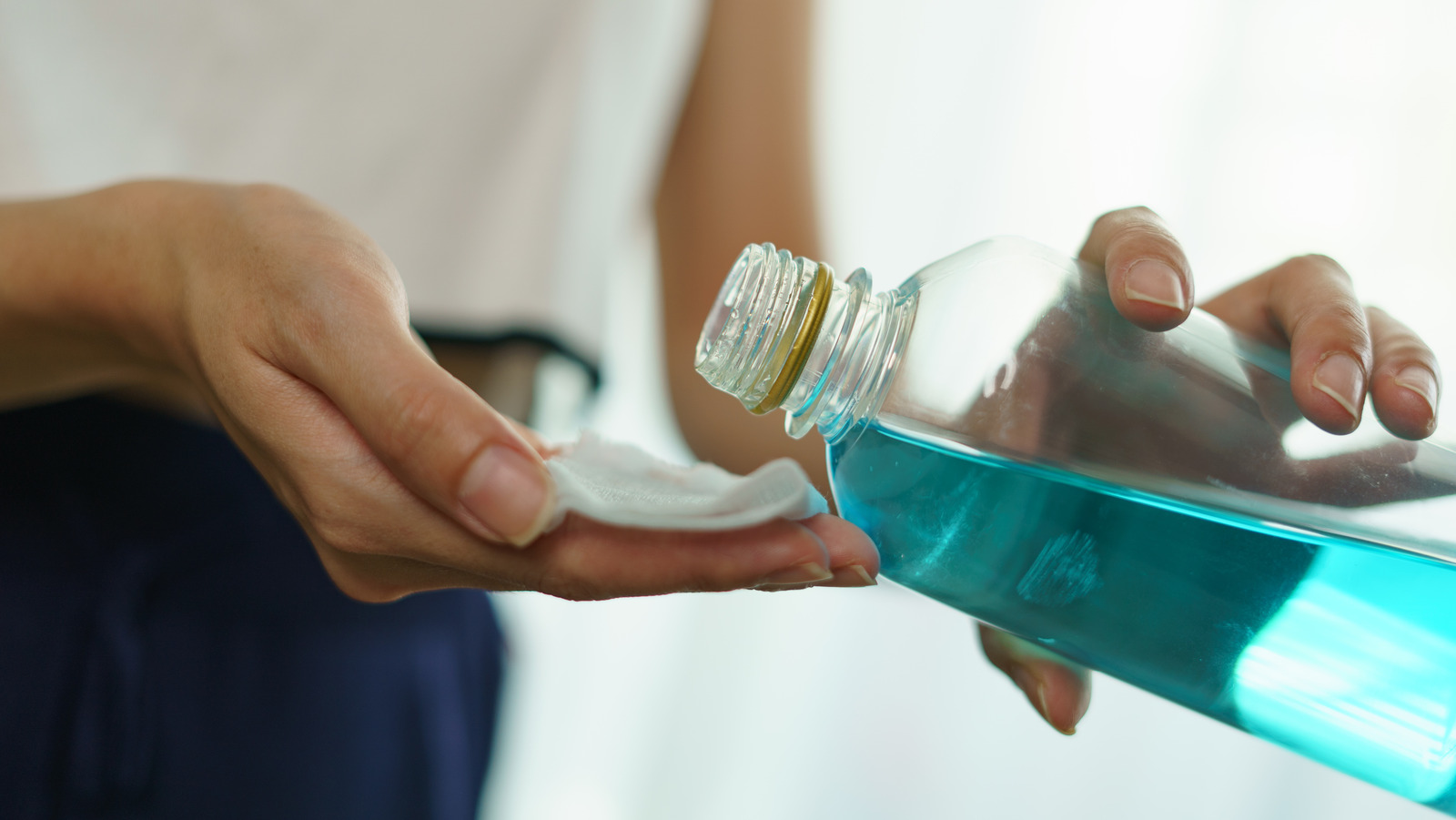
Clever Ways You Should Be Using Rubbing Alcohol Around The House – House Digest
Chances are, you have a bottle of rubbing alcohol in your medicine cabinet right now. The anti-bacterial liquid is a staple in every home first aid kit. It is made by mixing isopropyl alcohol — pure alcohol — with water. While isopropyl alcohol is too strong for use in a home, rubbing alcohol is generally safe to use. Did you know that this bathroom staple can be used for so much more than cleaning wounds?
That’s right, as great as it is at disinfecting cuts, rubbing alcohol can also be used in many other ways around the house. The solution is great for cleaning a variety of surfaces and can even help keep creepy crawly guests at bay. Read on to discover some of the many ways rubbing alcohol can be used around the house. Once you do, you’ll be ready to grab the bottle of it out from the medicine cabinet to get to work.
Rubbing alcohol can help you get rid of pests
 Nicoleta Ionescu/Shutterstock
Nicoleta Ionescu/Shutterstock
Do you need to deal with an infestation of ants or gid rid of cockroaches? If so, now might be the perfect time to try this clever rubbing alcohol hack. A diluted solution of rubbing alcohol can help you get rid of these and some other pests. When the bugs come into contact with it, it causes their wax coating to essentially melt away. When this coating is compromised, the critters end up dying. Another benefit of using rubbing alcohol is that some bugs will be repelled from areas where it’s sprayed.
To harness this power, add ½ cup rubbing alcohol and 4 cups water to a spray bottle. Then, spray the mixture directly on any insects that you see. Alternatively, you can spray it around areas where you have seen them or around houseplants that are being threatened by pests. Just remember that alcohol is flammable, so take care not to use this solution near any open flames or cooking appliances in the kitchen.
Make your floors clean and shiny with rubbing alcohol
 Hispanolistic/Getty Images
Hispanolistic/Getty Images
You can also use rubbing alcohol to keep the floors in your home clean. If you have wood, vinyl, tile, or laminate floors, try making a DIY mopping solution with 1/4 cup of rubbing alcohol, 1/2 cup of distilled white vinegar, 2 cups of warm water, and a few drops of liquid dish soap. You can even add some of your favorite essential oils if you desire a fragranced cleaner.
Rubbing alcohol dries quickly — a good characteristic for a floor cleaner. The fast evaporation means that there should be fewer streaks on your floors after each mopping session. Its cleansing properties will help it kill germs that may be present on the floor while also tackling grease and dirt. As a bonus, rubbing alcohol can remove stains from linoleum floors. You’ll want to use it without diluting it for this effect and have a scrub brush ready to give some TLC to each section of the flooring.
Clean your bathrooms using rubbing alcohol
 Solstock/Getty Images
Solstock/Getty Images
No one enjoys cleaning the bathroom, but it is a necessary task. If you’re trying to move away from using chemical-based cleaners, try using some rubbing alcohol instead. The gentler pH of the substance means that you can use it on many surfaces — such as quartz and granite — where more acidic cleansers may not be such a good idea. Rubbing alcohol can also be an effective glass cleaner for the mirrors and windows in your bathroom. It evaporates so quickly, it’s not likely to leave behind streaks.
Pouring rubbing alcohol directly onto these surfaces or trying to dampen a cleaning cloth with it can be wasteful. Instead, you might want to try the genius TikTok hack that transforms a standard bottle of rubbing alcohol into a spray bottle. Upcycle an old spray nozzle and connect it directly to the bottle of rubbing alcohol, and voilà, your cleaning solution is ready to get to work.
Use rubbing alcohol to erase permanent marker stains
 Iuliia Burmistrova/Getty Images
Iuliia Burmistrova/Getty Images
If you have permanent marker stains that you’ve been trying to remove with no success, you might be surprised by how effective some rubbing alcohol can be. Rubbing alcohol can be used on a variety of surfaces, including glass, plastic, painted walls, and even wood. The reason it’s so effective at banishing these marks is that it is a solvent. When it comes into contact with the ink molecules from the permanent marker, it breaks them down (dissolves them) making it possible to remove the stains from different surfaces in the home.
In addition to its ability to get marker stains off of hard surfaces, rubbing alcohol can also be used to tackle marks from pens and markers on clothing. To use the solvent to get rid of stains, lay out a few paper towels. Place the stained fabric over the towels, with the mark facing down. Then, use a cloth soaked with rubbing alcohol to blot around and over the stain. Gradually, the marker spot should be released from the clothing and soaked into the paper towels. When needed, replace the paper towels or move the item over a dry section until the stain is gone. Then, wash the garment in its normal cycle before wearing it.
Clean stainless steel with rubbing alcohol
 Andrey_Popov/Shutterstock
Andrey_Popov/Shutterstock
How much stainless steel do you have in your home? If you’re like many, you probably have a lot of items made from this material — including appliances, sinks, trash cans, and more. Keeping all of these materials clean, streak-, and fingerprint-free can be a real chore. Fortunately, rubbing alcohol can help you with this task as well.
Add equal parts rubbing alcohol and water to a spray bottle. Then, grab a soft cloth. Stay away from abrasive cleaners, like steel wool, to avoid scratching the stainless steel. Microfiber is an excellent choice because of its tiny fibers that will help pick up germs, dirt, and other debris. After you have the DIY spray and microfiber cloth ready, spray the surfaces of the items you wish to clean. Wipe it off following the direction of the grain. Because the alcohol evaporates so quickly, you should be left with a streak-free finish.
Rubbing alcohol can help you keep your blinds clean
 brizmaker/Shutterstock
brizmaker/Shutterstock
Dusting your blinds regularly is important to prevent build-up. However, every few months you’ll likely find that they need a deeper clean. Over time, dust and dirt may become caked onto the surface, and you won’t be able to remove it just using your duster.
Try using rubbing alcohol to clean your blinds and release these stuck-on messes. After vacuuming or dusting to remove loose debris, close the blinds, leaving the slats facing downwards. Then, spray the blinds with some rubbing alcohol, and use a microfiber cloth to wipe down the surface. As a solvent, the rubbing alcohol will break down any dust, dirt, and other messes that are stuck to the blinds, allowing you to easily wipe them away. If you’re cleaning blinds in several rooms — or have really dusty blinds, you might want to have a few extra cleaning cloths on hand to replace the current one if it gets too dirty.
Get rid of sticky residues with rubbing alcohol
 Rebeca Bolanos/Shutterstock
Rebeca Bolanos/Shutterstock
Sticky residues can be one of the most difficult things to clean up in a home. The next time you’re dealing with hairspray residue in the bathroom or the remains of a sticker that just wouldn’t peel off all the way, dip a cloth in some rubbing alcohol and let it sit over the area for several minutes. After the time has passed, use the cloth to wipe the stickiness away.
Once again, the reason this tip works so well is because rubbing alcohol is a solvent. The alcohol dissolves, or breaks down, residues. Once they’re broken down, they no longer adhere to the surface and can simply be wiped away with a cloth or paper towel. Remember, if you’re working in a bathroom or another small room, you’ll want to open a window or turn on a fan to ensure that there is adequate ventilation to protect yourself from inhaling the alcohol.
Rubbing alcohol can help you clean your sponges
 Bowonpat Sakaew/Shutterstock
Bowonpat Sakaew/Shutterstock
One of the dirtiest items in your home isn’t in the bathroom. It is in the kitchen. Believe it or not, kitchen sponges can harbor lots of bacteria that can potentially be spread to other surfaces that they’re used to clean. There are several possible ways you can clean a kitchen sponge, including washing it in the dishwasher or heating it up for a minute in the microwave. Another option is to use rubbing alcohol to refresh dirty sponges and bring them back to life.
Simply fill a lidded container with enough of the solution to cover the sponge. Place the sponge in the bowl, and make sure that it is submerged under the liquid. Cover the container with its lid, and leave it to soak for about one hour. Then, put on a pair of rubber gloves, squeeze out the excess alcohol, and rinse the sponge with cool water. The disinfecting powers of the alcohol will get to work killing bacteria that has built up inside the sponge.
Deodorize your shoes using rubbing alcohol
 HenadziPechan/Shutterstock
HenadziPechan/Shutterstock
Do your gym shoes smell like roses? Chances are that the answer is no. Fortunately, you don’t have to just accept the stench. You can try some rubbing alcohol to help you freshen them up. Add about ¾ cup rubbing alcohol and ¼ cup water to an empty spray bottle. Then, spritz the solution into the stinky shoes, gently misting the entire interior. Let the shoes dry for a few hours, and return to check on the progress. You should notice that they smell much better. If they’re not as fresh as you’d like them to be, repeat the steps one more time.
The reason rubbing alcohol is an effective shoe deodorizer is because of its bacteria-killing properties. The shoes stink because of the bacteria that is building up inside of them. So, when you spray rubbing alcohol over them and kill the bacteria, you simultaneously eliminate the odor.










































![iFi's GO Bar Kensei Dongle DAC Supports K2HD Technology With Some Samurai Swagger [Updated] iFi's GO Bar Kensei Dongle DAC Supports K2HD Technology With Some Samurai Swagger [Updated]](https://i0.wp.com/cdn.ecoustics.com/db0/wblob/17BA35E873D594/33FF/45A11/QTXOLJR4xDKSNMMk2WlTgjaIlvSgcYpeU1xJzUwIoYs/ifi-go-bar-kensei.jpg?w=768&ssl=1)
































